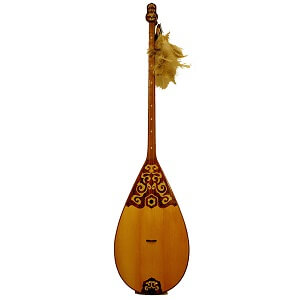Dombra
 The dombyra is a lute-style instrument. It is an ancient and quintessential piece of Kazakh culture and identity. In its most popular form, the dombyra has two-strings strung down a long, skinny neck and a pear-shaped body, flat at the front and rounded on the backside.
The dombyra is a lute-style instrument. It is an ancient and quintessential piece of Kazakh culture and identity. In its most popular form, the dombyra has two-strings strung down a long, skinny neck and a pear-shaped body, flat at the front and rounded on the backside.
The standard English spelling of dombra is taken from the Russian word. However, the instrument itself is not Russian. In Kazakhstan, one of the instrument’s most important homelands, it is known as домбыра (dombyra). This article will be considering the instrument from a Kazakh perspective.
In the post-Soviet period, Kazakhs have looked to the past to promote national symbols of their independent country and the dombyra has been high on their list. The dombyra is, in fact, so important to Kazakh national identity that there is a popular saying: “Naǵyz qazaq qazaq emes, naǵyz qazaq – dombyra” (Нағыз қазақ қазақ емес, нағыз қазақ – домбыра), which, translated, means “A real Kazakh is not a Kazakh, a real Kazakh is a dombra.”
In Central Asia, the history of the dombyra and similar instruments stretches back millennia. In 1989, high in the mountains of southeast Kazakhstan, Kazakh researchers discovered rock drawings believed to be at least 4,000 years old. Among the images, surrounded by four dancing figures, is a musical instrument shaped like a dombyra. Thus, it is likely that a dombrya-like instrument has been played in the region since almost the dawn of civilization. This speaks not only to its popularity but also to the influence it likely had on similar instruments.